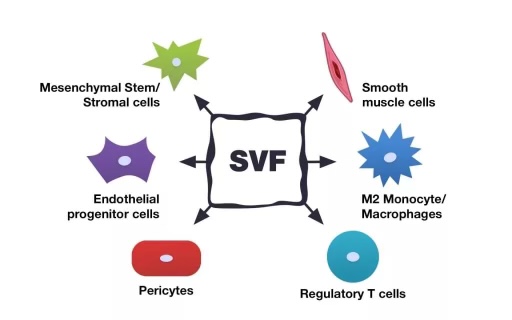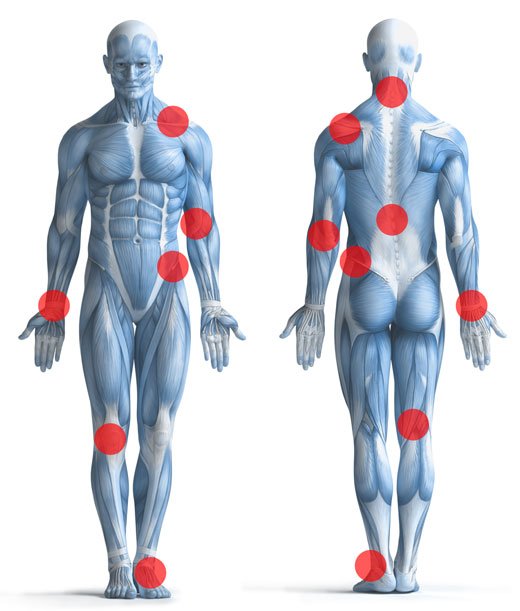SVF – Adipose Derived Stem Cells: Your Scientific Approach to Stem Cell Therapy
Discover the transformative power of Stromal Vascular Fraction (SVF), a cutting-edge treatment derived from adipose tissue.
This advanced approach to stem cell therapy provides targeted solutions for autoimmune, neurological, urological, pulmonary, ophthalmological, and orthopaedic conditions. SVF is a potent blend of diverse stem cell populations, growth factors, and essential biological elements.
The extraction process is straightforward and encompasses anesthesia, extraction, and cell injection, all completed within approximately four hours in an outpatient setting.

Backed by robust data, this treatment is well-received by patients and has undergone validation for safety in multiple clinical settings.
Strengthening the abdominal muscles can help prevent lower back pain.
One of the chief causes of lower back pain is weak abdominal muscles.
The abdominals hold the lower torso and if they are weak, the back muscles will be forced into strenuous positions and efforts.
Exploring SVF in Regenerative Medicine
Stromal Vascular Fraction (SVF) is extracted alongside fat cells during the processing of adipose tissue.
It encompasses a diverse range of precursor cells to adipose cells, including immune cells, fibroblasts, pericytes, and endothelial cells, alongside growth factors and active biological substances.
SVF has emerged as a focal point for specialists investigating stem cell therapies due to its promising therapeutic potential.
The process of isolating SVF cells is relatively straightforward, typically taking about 30–90 minutes using conventional liposuction techniques, and can be completed within a few hours at a clinic.
These potent stem cells can then be administered directly to affected areas through a minimally invasive procedure.
Explore the transformative possibilities of SVF in regenerative medicine.
The Stromal Vascular Fraction (SVF) consists of various cell subsets (as adapted from the original source).
Within the SVF, there is a diverse array of stem cells, including multipotent mesenchymal stromal cells (multipotent MSCs), pericytes, and supra-adventitial cells.
Furthermore, it incorporates progenitor cells with the potential to differentiate into various cell types like blood vessel wall cells and adipocytes, among others.
In addition to progenitor cells, the SVF includes mature cell types such as fibroblasts, smooth muscle cells, endothelial cells, and adipocytes.
Rich in growth factors and various other active biological elements, the SVF showcases a complex composition that contributes to its regenerative potential.

Furthermore, SVF therapy shows promise in addressing neurological disorders such as neuropathy, amyotrophic lateral sclerosis (ALS), and Parkinson’s disease.
Currently, numerous potential applications for adipose-derived stem cells are undergoing clinical examination.
The therapeutic potential of stromal vascular fraction (SVF) obtained from adipose tissue extends to the management of various common ailments and medical conditions, including:
– Rheumatoid arthritis
– Joint degeneration
– Osteoarthritis
– Spinal conditions
– Soft tissue injuries
– Ligament damage
– Migraines and tension-related headaches
– Diabetes
– Chronic ischemic heart disease
– Alopecia
– Erectile dysfunction
– Respiratory illnesses
– Various autoimmune disorders (this includes multiple sclerosis, lupus, and Crohn’s disease)
How Does SVF Function?
Stromal Vascular Fraction (SVF) is a substance derived from adipose (fat) tissue, presenting as a complex amalgamation of various cells, including adipose-derived stem cells (ADSCs), endothelial precursor cells, macrophages, fibroblasts, and diverse cell types.
When applied to diseased or damaged tissues, the heterogeneous cell composition of SVF contributes to healing and regeneration through several mechanisms:
1. Cytokine Secretion: The cells within SVF release cytokines and growth factors, creating an environment that diminishes inflammation, minimizes scar tissue formation, and encourages tissue growth.
2. Immunomodulation: SVF cells possess the ability to modify the immune response, potentially mitigating harmful inflammation that could impede the healing process.
3. Stimulating Neoangiogenesis: SVF cells play a role in promoting the formation of new blood vessels, aiding in the delivery of essential nutrients and oxygen to healing tissues, while also facilitating the removal of waste products.
4. Cell Differentiation: Certain cells within SVF exhibit the potential for differentiation into various cell types, offering the prospect of replacing damaged cells in the targeted tissue.
5. Supporting Matrix Remodeling: SVF cells release enzymes and other factors that contribute to the remodeling of the extracellular matrix, a pivotal process for effective tissue repair.
While ongoing research continues to delvelop into the exact mechanisms and the efficacy of SVF treatments across various medical conditions, investigations are actively exploring their applications in orthopedics, wound healing, cosmetic procedures, and beyond.
Clinical applications are in development, but their implementation is contingent on regulatory approval and adherence to ethical considerations.
Want to know more about SVF?
After you submit the above form, a regenerative medicine specialist from our office will reach out to you.
What occurs during the process?
Initial Procedures
 Before initiating the process, a comprehensive assessment of the patient’s medical history and symptoms is carried out.
Before initiating the process, a comprehensive assessment of the patient’s medical history and symptoms is carried out.
Once inside the operating room, the patient undergoes a sterilization procedure and is given either oral or twilight anesthesia, complemented by a local anesthetic.
Upon the successful onset of anesthesia, a minute incision, roughly the size of a grain of rice, is created in a region rich in fatty tissue, such as the buttocks, abdomen, or flank.
Specialized syringes are then employed to carefully extract fat tissue.
This harvested fat tissue, now known as lipoaspirate, undergoes treatment with a collagenase solution to break down the extracellular matrix and release cells from the fat tissue.
Following this, the mixture undergoes centrifugation to separate the stromal vascular fraction (SVF).
The SVF solution is subsequently administered to the patient.
Following the procedure, the patient may be monitored for a specific duration based on the particulars of the clinical process.
Key Distinction Between Multipotent MSCs and SVF:
Multipotent mesenchymal stromal cells (MSCs) are extensively studied and constitute a significant element of the stromal vascular fraction (SVF).
These MSCs possess the ability to differentiate into various cell types, including bone, cartilage, muscle, and fat cells.
Although MSCs are abundant in adipose tissue, their preparation for clinical applications involves meticulous laboratory cultivation under sterile conditions. On the contrary, SVF can be acquired and utilized shortly after liposuction without the necessity for such cultivation. S
VF not only shares the characteristics of MSCs but also encompasses additional types of stem cells and bioactive molecules, enhancing its therapeutic effects.
Therapeutic Advantages of MSCs:
The therapeutic advantages of multipotent MSCs stem from their ability to release active molecules such as cytokines and growth factors.
These bioactive substances play a crucial role in facilitating regenerative processes, encompassing the growth of new blood vessels and nerves, modulation of inflammation, prevention of cell death, attraction of stem cells to damaged regions, and encouragement of stem cell differentiation.
The multifaceted contributions of MSCs contribute significantly to their therapeutic efficacy in various medical applications.
Safety Profile of SVF:
Risk Incidence and Side Effects
Clinical trial results indicate that the local administration of SVF is generally well-tolerated, with no reported instances of tumor development, inappropriate tissue growth, or adverse reactions. The majority of patients undergo the procedure comfortably.
Cases of individual intolerance are exceptionally rare, though not entirely eliminable.
At Total Spine, our experts will supervise your treatment to enhance safety and efficacy, taking necessary precautions to minimize potential risks.
Outcome Monitoring:
We take pride in being affiliated with the Cell Surgical Network, a global alliance of highly specialized physicians.
Each member of the CSN utilizes the Regenatrak Database to track their patients’ health outcomes specific to their conditions for five years post-treatment.
This data is systematically collected and analyzed to aid CSN physicians in making informed decisions regarding personalized cell therapy.
The information gathered has contributed to the development of numerous cutting-edge, peer-reviewed articles in the field, accessible through the providedlink.https://cellsurgicalnetwork.com/publications-csn/

